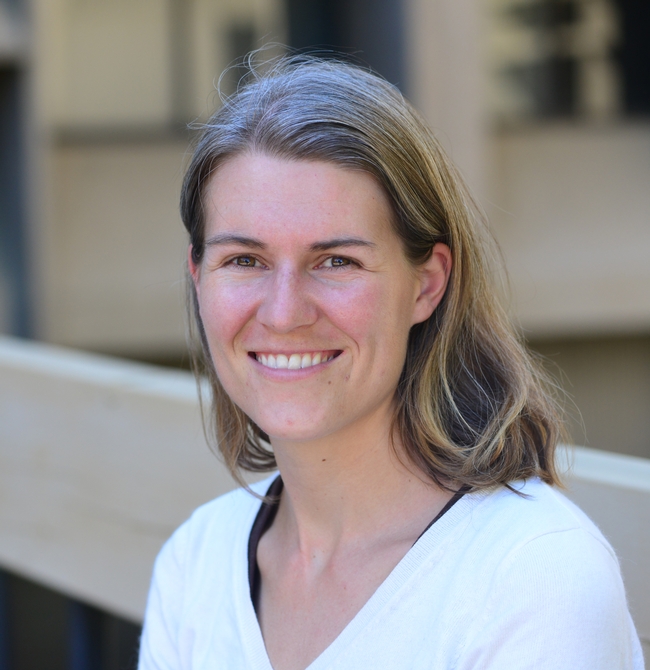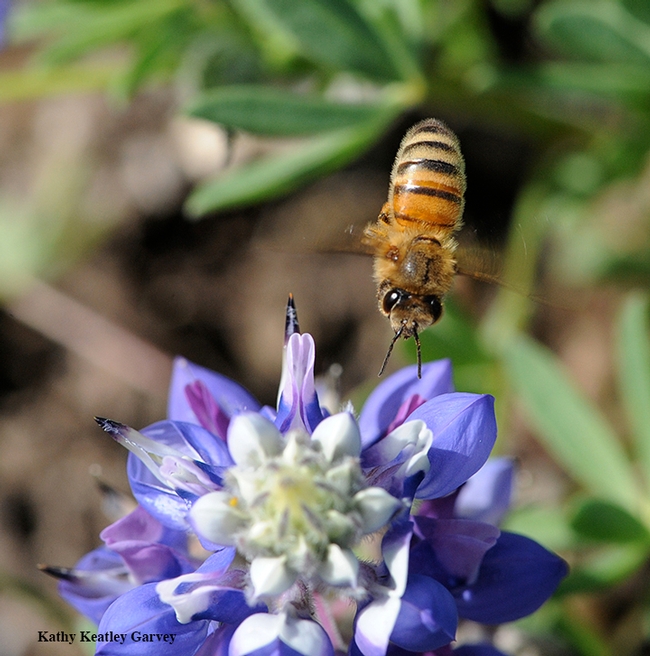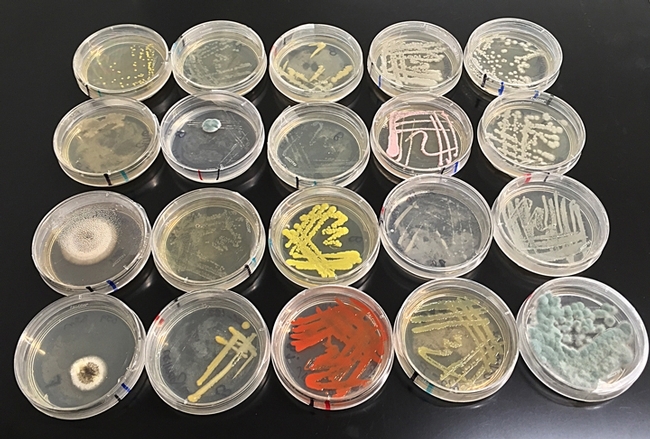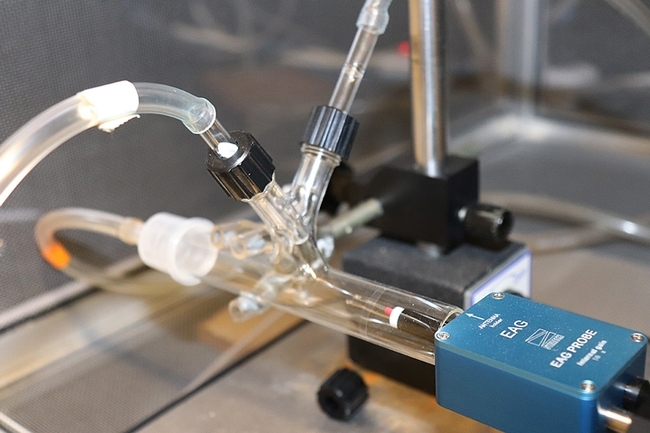
They buzz toward a blossom, sip nectar, and then head for another blossom. Typical, right?
But there's much more going on than you think.
It's not just the nectar that she's scented.
UC Davis community ecologist Rachel Vannette has just published a paper in New Phytologist journal that shows nectar-living microbes release scents or volatile compounds, too, and can influence a pollinator's foraging preference.
The groundbreaking research shows that nectar-inhabiting species of bacteria and fungi “can influence pollinator preference through differential volatile production,” said Vannette, an assistant professor in the UC Davis Department of Entomology and Nematology.
“This extends our understanding of how microbial species can differentially influence plant phenotype and species interactions through a previously overlooked mechanism,” Vannette said. “It's a novel mechanism by which the presence and species composition of the microbiome can influence pollination.”
“Broadly, our results imply that the microbiome can contribute to plant volatile phenotype,” she said. “This has implications for many plant-insect interactions.”
Their paper, titled “Nectar-inhabiting Microorganisms Influence Nectar Volatile Composition and Attractiveness to a Generalist Pollinator,” may explain in part the previous documented extreme variation floral volatiles that Robert Junker of University of Salzburg, Austria, and his team found; New Phytologist published their work in March 2017.
In their study, the Vannette team researchers first examined field flowers for the presence of nectar-inhabiting microbes, and in collaboration with co-authors Caitlin Rering and John Beck of the U.S. Department of Agriculture's Agricultural Research Service (USDA-ARS), Gainesville, Fla, characterized the headspace of four common fungi and bacteria in a nectar analog. Next, they used an intricate setup to quantify the antennal and behavior responses of honey bees to the chemical compounds. Finally, when they examined the scent of flowers in the field, they found that flowers which contained high densities of microorganisms also contained volatile compounds likely produced by those microbes, suggesting that microbial scent production can be detected and used by pollinators.
Although microbes commonly inhabit floral nectar, microbial species differ in volatile profiles, they found. “Honey bees detected most of the microbial volatiles or scents that we tested,” Vannette said, “and they distinguished the solutions of yeasts or bacteria based on volatiles only.” This suggests that pollinators could choose among flowers based on the microbes that inhabit those flowers.
The yeast Metschnikowia reukaufii produced the most distinctive compounds (some shared with the fruity flavors in wine) and was the most attractive of all microbes compared. This yeast is commonly found in flower nectar and is thought to hitch a ride on pollinators to travel from one flower to the next. Its scent production may help it attract pollinators, which then help the yeast disperse among flowers.
The Harry H. Laidlaw Jr. Honey Bee Research Facility, UC Davis, provided the honey bees. More than 20 species of flowers--mostly natives--were used in the survey, including canyon delphinium or canyon larkspur (Delphinium nudicaule), sticky monkey flower (Mimulus aurantiacus), salvia (Lepechinia calycina) and purple Chinese houses (Collinsia heterophylla). The samplings were done in the spring and early summer, when the natives are at their peak.
Co-authors of the paper are Caitlin Rering, postdoctoral fellow at USDA-ARS, Gainesville, Fla.; John Beck researcher at USDA-ARS; Griffin Hall, junior specialist in the Vannette lab; and Mitch McCartney in UC Davis Department of Mechanical and Aerospace Engineering.
The USDA and USDA-ARS funded the research.
About Rachel Vannette: She joined the UC Davis Department of Entomology and Nematology in September of 2015 from Stanford University where she was a postdoctoral fellow.
A native of Hudsonville, Mich., Vannette received her bachelor of science degree in biology with honors at Calvin College, Grand Rapids, Mich., and her doctorate in ecology and evolutionary biology from the University of Michigan, in 2011. Her dissertation was entitled “Whose Phenotype Is It Anyway? The Complex Role of Species Interactions and Resource Availability in Determining the Expression of Plant Defense Phenotype and Community Consequences.”
In her PhD research, she examined how variation in nutrient availability and plant associations with mycorrhizal fungi belowground influenced defense chemistry in milkweed plants and the performance of a specialist herbivore (Danaus plexippus). She found that resource-based tradeoffs can in part explain plant allocation to antiherbivore defense and mycorrhizal fungi. This work also describes that plant genotypes vary in their investment in defense and associations with below ground fungi.
As a Stanford University postdoctoral fellow, funded by a life sciences research fellowship, Vannette examined the community ecology of plant-associated microorganisms. Using diverse systems, she studied the assembly of microbial communities, microbial response to anthropogenic changes like habitat fragmentation, and microbial effects on plant-pollinator interactions.
The National Wildlife Research Foundation featured Vannette's research on monarchs and milkweed in its March 11, 2013 piece on “Catering to Butterfly Royalty." The article, by author Doreen Cubie, focused on Vannette's research as a graduate student at the University of Michigan. Vannette and advisor Mark Hunter studied five common species of milkweeds, the host plant for monarchs. They found that climate change may disrupt the chemistry of milkweeds, and encouraged gardeners to help the monarchs by planting more of these critical host plants.
Attached Images:

A honey bee heads toward a lupine blossom. It's not just the nectar she's scented. UC Davis community ecologist Rachel Vannette has just published a paper in New Phytologist journal that shows nectar-living microbes release scents or volatile compounds, too, and can influence a pollinator's foraging preference. (Photo by Kathy Keatley Garvey)

Microbial stains (fungi and bacteria) isolated from floral nectar. (Photo by Rachel Vannette)

This is the electroantennogram (EAG) assay set-up. (Photo by Bryan Smith, USDA-ARS)